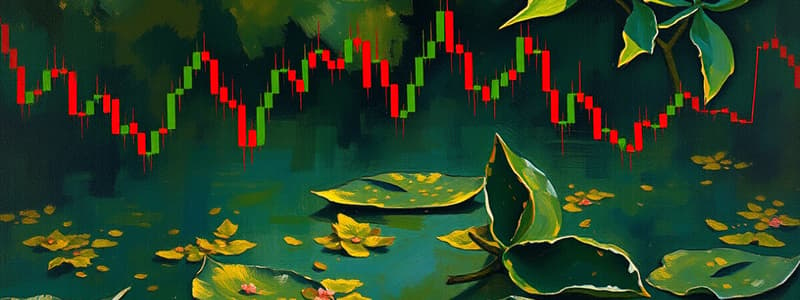Podcast
Questions and Answers
What is the significance of lagging indicators in confirming a trend?
What is the significance of lagging indicators in confirming a trend?
Lagging indicators are significant because they help confirm that a trend is genuinely occurring by following price action.
Why is it considered risky to trade against a prevailing trend?
Why is it considered risky to trade against a prevailing trend?
It is risky to trade against a prevailing trend because it can lead to greater losses due to the market's continued movement in the opposite direction.
Explain the formula for calculating a Simple Moving Average (SMA).
Explain the formula for calculating a Simple Moving Average (SMA).
The formula for calculating an SMA is $SMAn = (price1 + price2 + … + pricen) / n$ where n is the number of periods.
What impact does increasing the number of periods in an SMA calculation have on the indicator?
What impact does increasing the number of periods in an SMA calculation have on the indicator?
How do leading indicators differ from lagging indicators in trend analysis?
How do leading indicators differ from lagging indicators in trend analysis?
What does it mean when a trend is described as 'weakening'?
What does it mean when a trend is described as 'weakening'?
In an upward prevailing trend, what should traders look for based on leading indicators?
In an upward prevailing trend, what should traders look for based on leading indicators?
Describe the role of other analysis techniques when using indicators for trading.
Describe the role of other analysis techniques when using indicators for trading.
What are the two broad types of trading indicators and how do they differ in function?
What are the two broad types of trading indicators and how do they differ in function?
Name a couple of popular lagging indicators and briefly describe their primary role in trading.
Name a couple of popular lagging indicators and briefly describe their primary role in trading.
What is a key disadvantage of using lagging indicators in trading?
What is a key disadvantage of using lagging indicators in trading?
Explain what leading indicators are and give an example of one.
Explain what leading indicators are and give an example of one.
What are the three basic functions performed by trading indicators?
What are the three basic functions performed by trading indicators?
Identify a major risk associated with solely relying on leading indicators in trading strategies.
Identify a major risk associated with solely relying on leading indicators in trading strategies.
What are the implications of the phrase 'confirmation vs catching a trend' when using lagging indicators?
What are the implications of the phrase 'confirmation vs catching a trend' when using lagging indicators?
How might the use of indicators enhance a trader’s analysis of the market?
How might the use of indicators enhance a trader’s analysis of the market?
Flashcards are hidden until you start studying
Study Notes
Overview of Trading Indicators
- Technical indicators are mathematical formulas that analyze price charts to provide insights for traders.
- They help identify trends, momentum, support and resistance, and volatility.
Types of Indicators
- Indicators fall into two main categories: lagging indicators and leading indicators.
Lagging Indicators
- Definition: Follow market price action and confirm trends after they are established, often referred to as trend-following indicators.
- Benefits: Help affirm existing trends, reducing the likelihood of false signals.
- Drawbacks: May result in delayed entries/exits, potentially causing missed opportunities in fast-moving markets.
- Examples:
- Moving Averages
- Moving Average Convergence Divergence (MACD)
- Parabolic SAR
- Bollinger Bands
Leading Indicators
- Definition: Also known as oscillating indicators, they aim to predict future price movements by identifying overbought or oversold conditions.
- Function: Range between two levels, typically 0 and 100, suggesting potential reversals or continuation of price movements.
- Benefits: Useful for early entry and exit signals in trading systems.
- Drawbacks: May lead to over-reliance, causing traders to ignore market trends.
- Examples:
- Relative Strength Index (RSI)
- Stochastics
Functions of Indicators
- Indicators serve three basic functions: alerting traders to changes, confirming trends, and predicting price movements.
- Alert: Notify traders about weakening trends that may indicate a reversal.
- Confirm: Lagging indicators verify that a trend is currently in effect.
- Predict: Leading indicators identify overextended market conditions for potential entry/exit points.
Using Indicators Effectively
- Indicators should be used in conjunction with other analytical techniques to improve trading decisions.
- Following prevailing trends is crucial; for example, seek buying opportunities on oversold signals during uptrends and selling signals on overbought conditions during downtrends.
Moving Averages (MA)
- Moving averages are a specific type of lagging indicator that smooths out price data to highlight trends.
- Calculation Example:
- Simple Moving Average (SMA) is calculated by summing the prices over a specific number of periods and dividing by that number.
- SMA Example:
- To find the 5-day SMA, sum the last five closing prices and divide by five.
- Impact: More periods result in smoother price action, but too many can delay trend confirmation, while too few can introduce excessive noise.
Studying That Suits You
Use AI to generate personalized quizzes and flashcards to suit your learning preferences.




